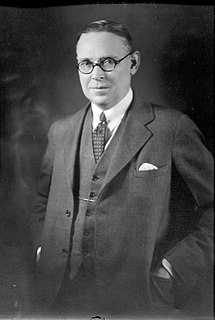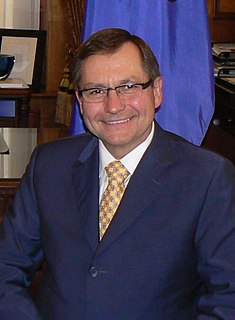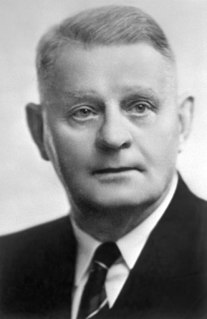
Ernest Charles Manning,, a Canadian politician, was the eighth premier of Alberta between 1943 and 1968 for the Social Credit Party of Alberta. He served longer than any other premier in the province's history and was the second longest-serving provincial premier in Canadian history. Manning's 25 consecutive years as Premier was defined by strong social conservatism and fiscal conservatism. He was also the only member of the Social Credit Party of Canada to sit in the Senate and, with the party shut out of the House of Commons in 1980, was its last representative in Parliament when he retired from the Senate in 1983.

Richard Gavin "Dick" Reid was a Canadian politician who served as the sixth premier of Alberta from 1934 to 1935. He was the last member of the United Farmers of Alberta (UFA) to hold the office, and that party's defeat at the hands of the upstart Social Credit League in the 1935 election made him the shortest serving premier to that point in Alberta's history.

The Executive Council of Alberta, or more commonly the Cabinet of Alberta, is the Province of Alberta's equivalent to the Cabinet of Canada. The government of the province of Alberta is a constitutional monarchy and parliamentary democracy with a unicameral legislature—the Legislative Assembly, which consists of 87 members elected first past the post (FPTP) from single-member constituencies. The premier is normally a member of the Legislative Assembly, and usually draws the members of Cabinet from among the members of the Legislative Assembly. The legislative powers in the province however, lie with the Legislative Assembly of Alberta. Its government resembles that of the other Canadian provinces. The capital of the province is Edmonton, where the Alberta Legislative Building is located. Government is conducted after the Westminster model.

The Government of Alberta refers to the provincial government of the province of Alberta. Its powers and structure are set out in the Constitution Act, 1867.

The Klein Ministry was the combined Cabinet, chaired by Premier Ralph Klein, and Ministers that governed Alberta from the mid-point of the 22nd Alberta Legislature from December 14, 1992, to the mid-point of the 26th Alberta Legislature until December 14, 2006.

The Stelmach Ministry was the combined Cabinet, chaired by thirteenth Premier Ed Stelmach, and Ministers that governed Alberta shortly after the conclusion of the first session of the 26th Alberta Legislature from December 14, 2006, to the mid-point of the fourth session of the 27th Alberta Legislature on October 7, 2011.

The 1937 Social Credit backbenchers' revolt took place from March to June 1937 in the Canadian province of Alberta. It was a rebellion against Premier William Aberhart by a group of backbench members of the Legislative Assembly (MLAs) from his Social Credit League. The dissidents were unhappy with Aberhart's failure to provide Albertans with C$25 monthly dividends through social credit as he had promised before his 1935 election. When the government's 1937 budget made no move to implement the dividends, many MLAs revolted openly and threatened to defeat the government in a confidence vote.

Joseph Lucien Paul Maynard was a lawyer and a provincial politician from Alberta, Canada. He served in the Legislative Assembly of Alberta from 1935 to 1955 as a member of the Social Credit Party.
Rev. William Morrison was a farmer, church minister, soldier and politician from Alberta, Canada. He served as a member of the Legislative Assembly of Alberta for a short time in 1935 sitting with the Social Credit caucus in government.

The Redford Ministry was the combined Cabinet, chaired by fourteenth Premier Alison Redford, and Ministers that governed Alberta halfway through the fourth session of the 27th Alberta Legislature from October 7, 2011, to the early part of the second session of the 28th Alberta Legislature on March 23, 2014.
The Getty Ministry was the combined Cabinet, chaired by Premier Don Getty, and Ministers that governed Alberta from the mid-point of the 20th Alberta Legislature from November 1, 1985, to nearly the end of the 22nd Alberta Legislature until December 14, 1992.
The Lougheed Ministry was the combined Cabinet, chaired by Premier Peter Lougheed, and Ministers that governed Alberta from the 17th Alberta Legislature from September 10, 1971, to mid-point of the 20th Alberta Legislature until November 1, 1985.
The Strom Ministry was the combined Cabinet, chaired by Premier Harry Strom, and Ministers that governed Alberta from the party way through the 16th Alberta Legislature from December 12, 1968, to end of the end of the 16th Legislature and the swearing in of Premier Peter Lougheed on September 10, 1971.

The Manning Ministry was the combined Cabinet, chaired by Premier Ernest Manning, and Ministers that governed Alberta from the part way through the 9th Alberta Legislature from May 31, 1943, to mid-point of the 16th Alberta Legislature on December 12, 1968.

The Reid Ministry was the combined Cabinet, chaired by Premier Richard Gavin Reid, and Ministers that governed Alberta from part way through the 7th Alberta Legislature from July 10, 1934, to September 3, 1935.

The Brownlee Ministry was the combined Cabinet, chaired by Premier John Edward Brownlee, and Ministers that governed Alberta from part way through the 5th Alberta Legislature from November 23, 1925, to part way through the 7th Alberta Legislature on July 10, 1934.

The Greenfield Ministry was the combined Cabinet, chaired by Premier Herbert Greenfield, and Ministers that governed Alberta during the 5th Alberta Legislature from August 13, 1921 to November 23, 1925.

The Stewart Ministry was the combined Cabinet, chaired by Premier Charles Stewart, and Ministers that governed Alberta during the 4th Alberta Legislature from October 30, 1917, to August 13, 1921.

The Sifton Ministry was the combined Cabinet, chaired by Premier Arthur Sifton, and Ministers that governed Alberta party way through the 2nd Alberta Legislature beginning on May 26, 1910, through the 3rd Alberta Legislature to October 30, 1917.














